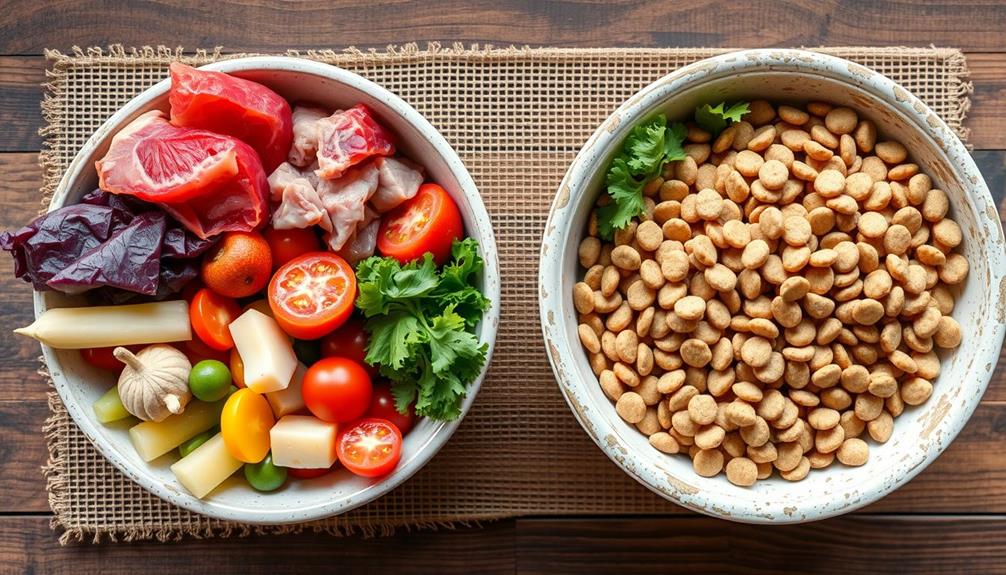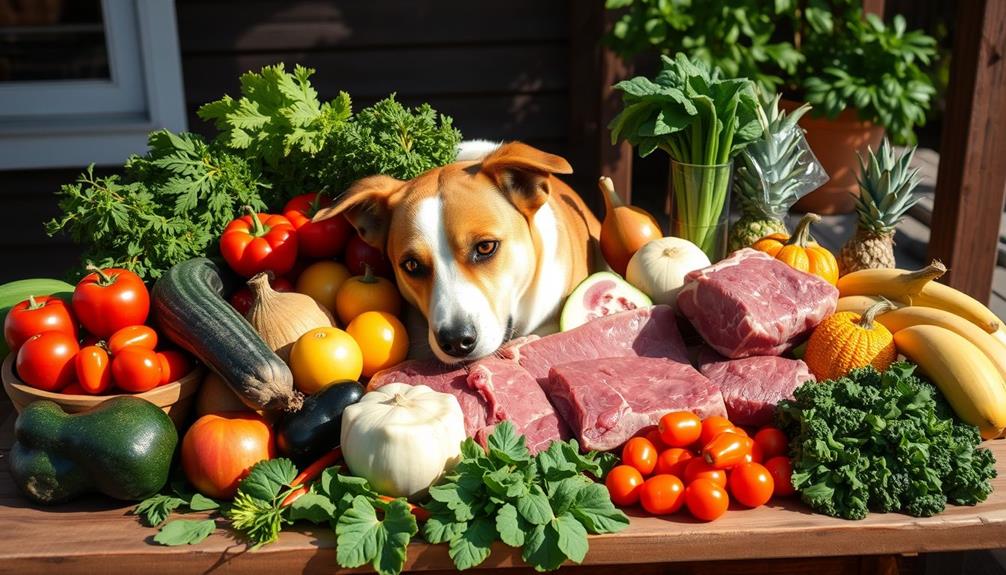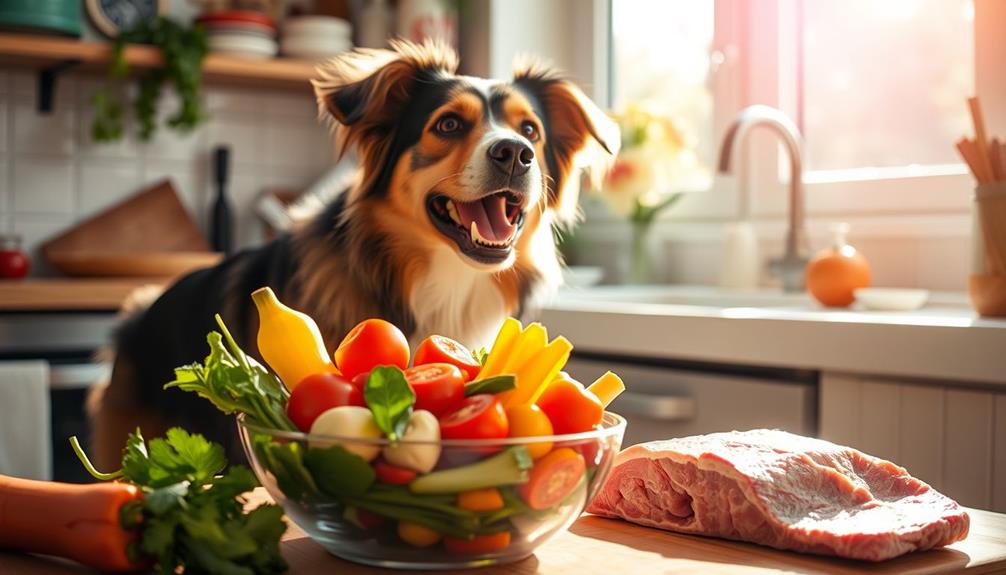You can mix raw food with kibble, and it can actually boost your dog's nutrition. Many myths suggest that combining these diets causes digestive issues, but that's not true if you shift gradually. Start with small amounts of raw food and monitor your dog's response. A balanced approach, like a 50/50 ratio after a few days, often works well. This method provides variety and keeps meals interesting for your dog. Just remember to observe your pup for any changes and consult your vet for tailored advice. There's much more to discover about doing this safely and effectively.
Key Takeaways
- Mixing raw food with kibble can be safe if introduced gradually over 4-6 days to prevent digestive upset.
- Dogs' digestive systems can handle both raw and kibble together without issues when properly transitioned.
- A balanced 50/50 ratio of raw food to kibble can optimize nutrition, but adjustments may be needed based on individual dog needs.
- Gradual mixing allows gut bacteria to adapt, reducing risks of harmful bacterial growth and improving digestion.
- Consulting a veterinarian can help tailor the mixed diet to your dog's specific dietary requirements and health concerns.
Myths About Mixing Diets
When it comes to mixing raw food with kibble, many myths can create unnecessary fear among dog owners. One common myth about mixing kibble suggests it leads to digestive problems. However, research shows that issues often arise from sudden dietary changes, not the act of mixing itself.
Your dog's digestive system can handle both types of food effectively, just like a hamster's diet must be balanced for ideal health, as noted in the proper diet guidelines.
Another misconception is that mixing raw and kibble can cause harmful bacterial growth in the gut. In reality, if you gradually introduce a combined diet, your dog's gut bacteria can adapt, reducing any potential risks.
It's also thought that raw food and kibble digest at vastly different rates, but that's not the case. The digestive tract processes food based on macronutrients rather than its source, meaning your dog can digest both foods together without issues.
Benefits of Combined Feeding
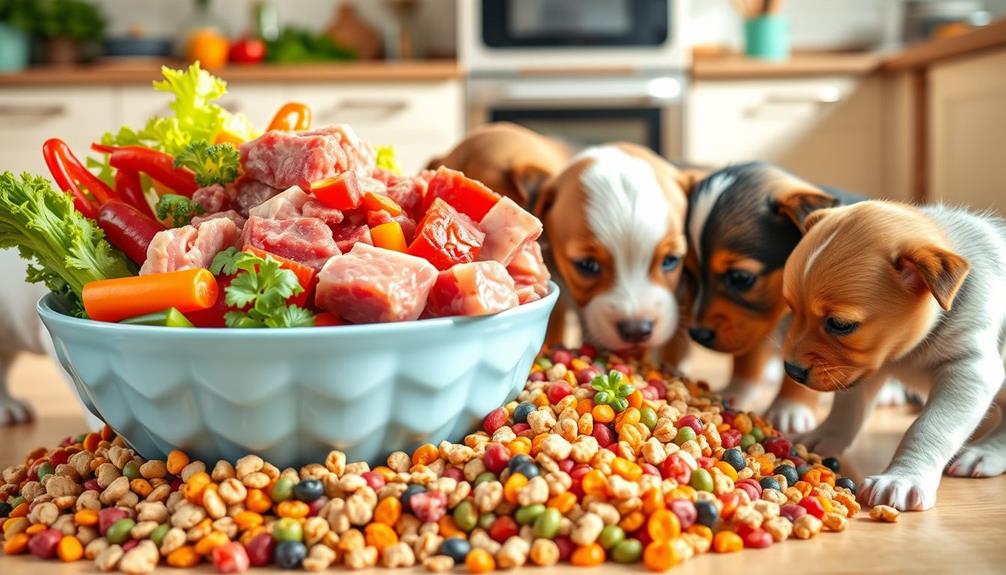
Mixing raw food with kibble offers numerous benefits that can greatly enhance your dog's health. By incorporating raw food, you're not only improving digestion but also boosting your dog's immune system. Even a small 10% inclusion of raw food can yield significant health benefits, including reduced allergy symptoms.
Additionally, offering a variety of flavors, such as healthy dog snacks, can keep your dog engaged and satisfied while adapting to a mixed diet.
Here are some key advantages of combined feeding:
- Nutritional Variety: A mix allows you to tailor the diet based on your dog's unique needs, considering factors like age and activity level.
- Improved Digestion: Gradually introducing raw food can help prevent gastrointestinal upset, allowing your dog's digestive system to adjust smoothly.
- Cost-Effective: Using raw food as a topper on kibble can extend your dog food supply while integrating raw nutrition.
- Safe Diet: Long-term mixing has proven to be well-tolerated and safe for dogs, debunking myths about digestive issues.
Transitioning to Mixed Diets

Introducing raw food into your dog's diet can be a straightforward process that builds on the benefits of combined feeding. Start by gradually mixing raw food with kibble over 4-6 days, allowing your dog's digestive systems to adapt. This gradual adjustment reduces the risk of digestive upset and helps your dog adjust to the new flavors and textures.
It's also important to monitor your dog's behavior during this adjustment, as changes in diet can sometimes affect their mood and energy levels, similar to how managing behavioral issues in seniors requires careful observation.
Aim for a 50/50 ratio of raw food to kibble by day six, ensuring a balanced diet. During this phase, consistency in feeding methods is essential. Monitor your dog's response closely for any signs of digestive issues or adverse reactions, as this will help you tailor the approach to their specific health needs.
Mixing raw food as a topper to kibble can enhance the nutritional value of meals and make the new diet more appealing. Adjusting the ratios based on your dog's age, activity level, and overall health allows for a personalized diet that best suits them.
Recommended Ratios for Mixing
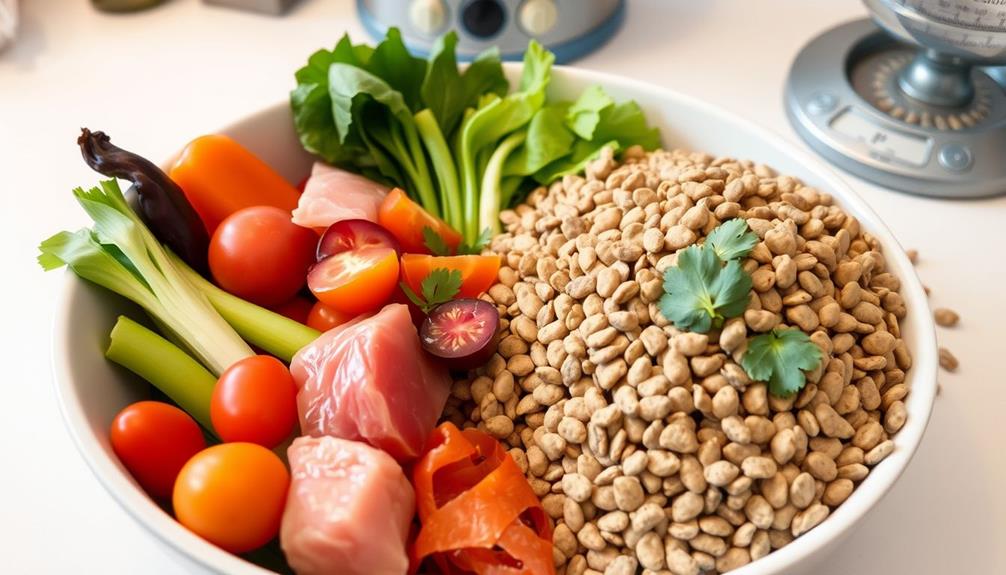
Achieving the right balance in your dog's diet is essential for their health and happiness. The recommended ratios for mixing raw food with kibble can vary based on your dog's individual health needs and preferences. Some dogs thrive on a 50-50 mix, while others may do better with a higher proportion of raw food.
A gradual shift over 4-6 days is advisable to allow your dog's digestive system to adapt smoothly. Additionally, it's important to take into account the nutritional benefits of different food types, as some may enhance your dog's overall well-being, similar to gout-friendly diet practices for humans.
Here are some key points to keep in mind when determining the mixing ratio:
- Start small: Even a 10% raw food addition can provide health benefits.
- Monitor closely: Watch your dog's response during the shift; adjustments may be needed.
- Consult your vet: A professional can help you tailor the ratio to your dog's specific dietary needs.
- Be flexible: Lifestyle and budget can influence how much raw food you incorporate.
Ultimately, finding the right balance requires patience and observation. By taking the time to adjust the ratios and consulting with your vet, you'll guarantee your four-legged friend receives the best possible diet.
Safety Considerations When Mixing
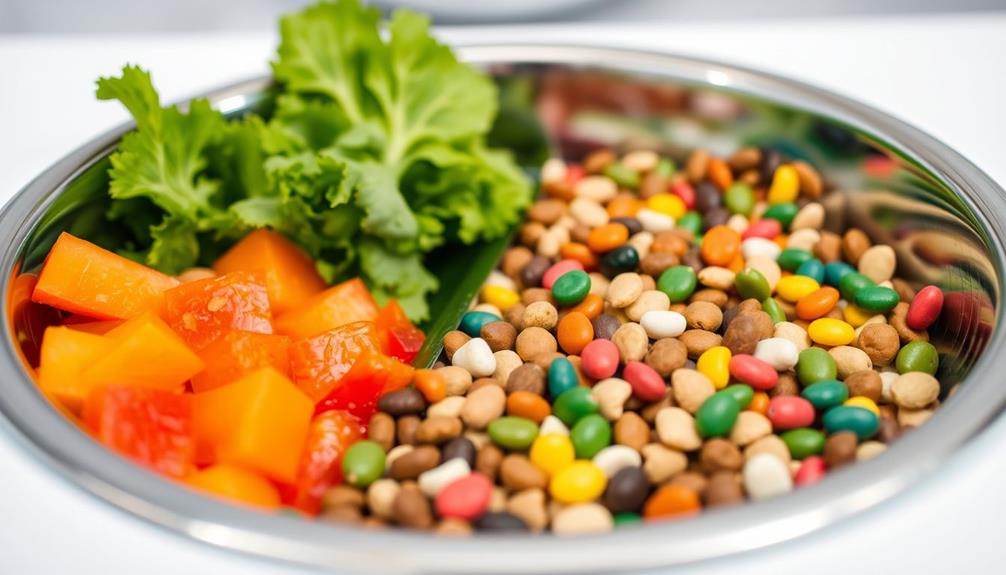
When you mix raw food with kibble, it's important to prioritize your dog's safety and health. A sudden change in diet can shock your dog's digestive system, leading to potential digestive issues. To mitigate this, consider a gradual introduction of raw dog food into their meals.
Start by adding a small percentage of raw food to kibble over 4-6 days, allowing gut bacteria to adapt and reducing the likelihood of digestive distress. Incorporating a balanced diet rich in nutrients can enhance your dog's overall health and well-being, reflecting the significance of a balanced diet for longevity.
Maintaining stable ratios while mixing is essential for preventing any gastrointestinal upsets. Monitor your dog's response carefully; if you notice any adverse reactions, you may need to adjust the ratios or slow down the introduction process.
This gradual change can also enhance the nutritional value of their diet without overwhelming their system. Before making any dietary changes, don't forget to consult with your veterinarian. They can help guarantee that the mixed diet meets your dog's individual dietary needs and health requirements.
With the right approach, mixing raw food with kibble can be a safe and beneficial option for your furry friend. Always prioritize their well-being during this change.
Frequently Asked Questions
Is It Okay to Mix Raw and Kibble?
It's okay to mix raw and kibble. Start with a small amount of raw food, monitor your dog's digestion, and adjust as needed. This approach can enhance their nutrition while keeping them healthy and happy. If your dog seems to thrive on the raw food, gradually increase the amount and consider incorporating some raw food in kibble. This balanced approach can provide the benefits of both raw and kibble diets, offering a variety of textures and flavors for your dog to enjoy. Just be sure to consult with your veterinarian to ensure that you are meeting all of your dog’s nutritional needs.
What Raw Food Can You Add to Kibble?
You can supercharge your dog's kibble with raw meats, fruits, and veggies! Toss in raw eggs for a shiny coat, or drizzle bone broth for a drool-worthy meal. Start small, and watch their excitement soar!
How Do You Balance Raw and Kibble?
To balance raw and kibble, start with a 50-50 mix, adjusting as needed. Gradually introduce the combination, monitor your dog's response, and consult your vet for personalized recommendations based on their specific needs.
Can I Mix Fresh Pet Food With Dry Food?
About 70% of pet owners mix fresh food with dry kibble for a balanced diet. You can safely combine them, gradually introducing fresh options to help your dog's digestion adapt without causing upset.
Conclusion
In summary, mixing raw food with kibble can be a great way to enhance your pet's diet, combining the best of both worlds. With the right approach and understanding, you can provide your furry friend with a nutritious meal that suits their needs. Isn't it exciting to think about the variety you can offer? Just remember to shift gradually and keep safety in mind, ensuring your pet stays happy and healthy.

